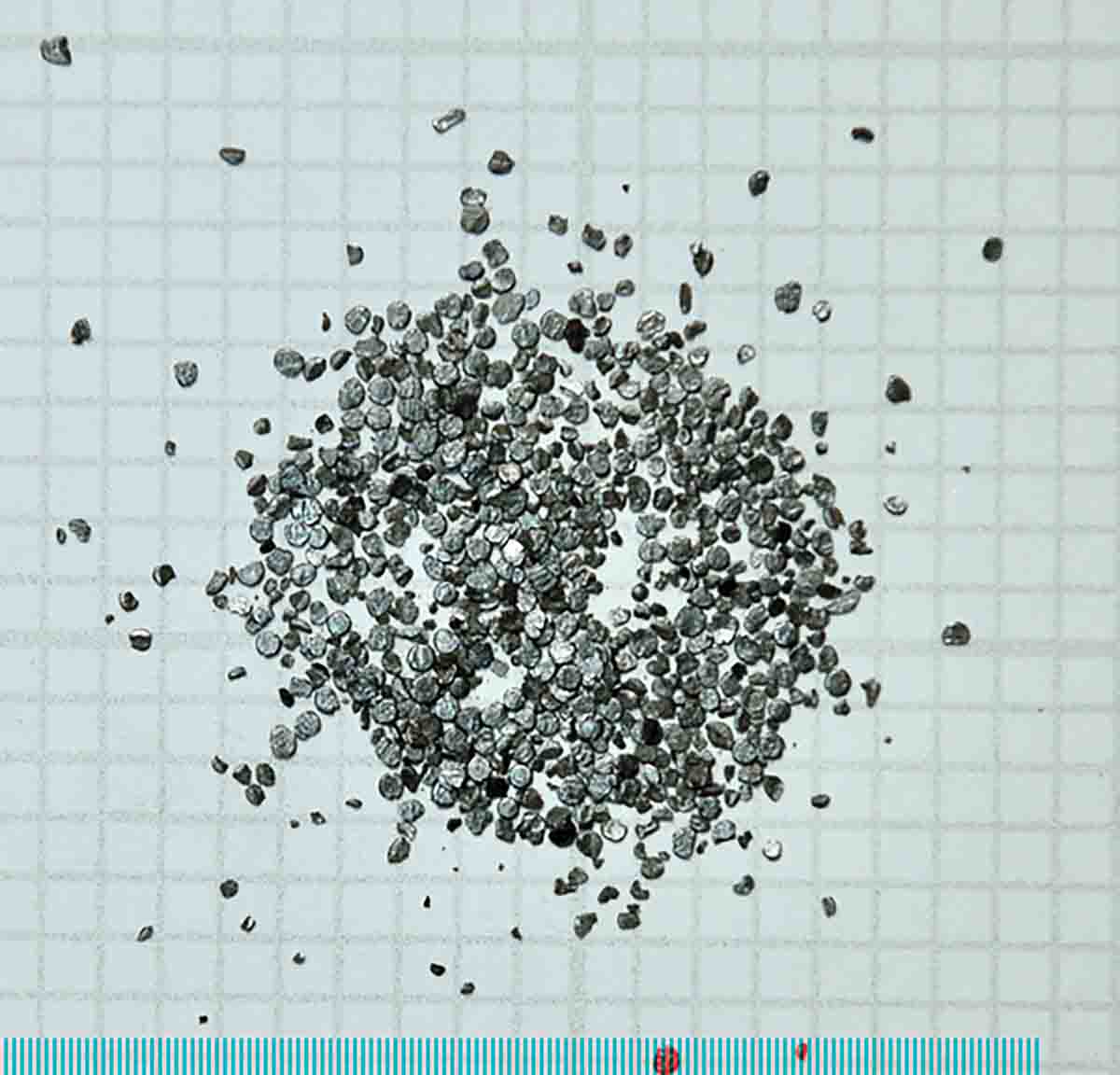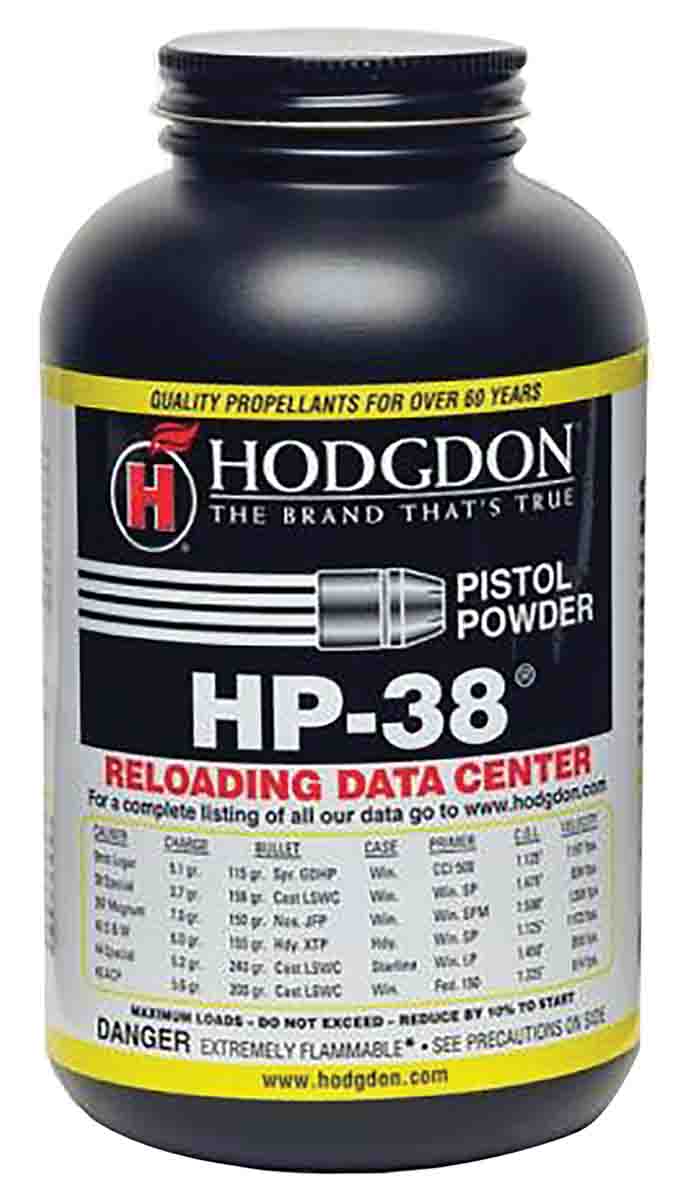Propellant Profiles
Hodgdon HP-38
column By: Randy Bimson | February, 22

In the grand scheme of things, Alliant’s Bullseye has an ever-sodeserved reputation of delivering an exceptionally high degree of accuracy and uniformity of pressures and velocity in target loads. HP-38 has gained an equally admirable reputation of providing superlative accuracy, and in contrast to Bullseye, by Hodgdon’s summation, HP-38 is a very versatile propellant powder. Bullseye is a tough act to follow, but I think it is fair to say that Hodgdon HP-38 has done a very admirable job of it and is nipping at the heels of Bullseye.

The outstanding feature of HP-38, in my experiences, is the exceptionally broad spectrum of different handgun cartridges, well over 25 by my count, and that there is an abundance of loading data available from reputable sources, including Wolfe Publishing’s own LoadData.com.
HP-38 covers the spectrum from the diminutive .25 Auto to the often mentioned target loads for .38 Special and .45 Auto from midrange to heavy loads for cartridges like the .44 Magnum and .45 Colt to high-velocity, personal protection and small-game hunting loads for small capacity cases (like the .30 Luger, .380 Auto and 9mm Luger). For shooters interested, Speer even has load data for shotshells for .38 Special/.357 Magnum, .44 Special/.44 Magnum and .45 Colt.
HP-38, like its identical twin, Winchester 231, is a double-base powder with a nitroglycerine content of 22.5 percent. HP-38 is classified as a spherical-type powder; however, during the manufacturing process, the silver-gray granules are run through a series of rollers resulting in granules that are quite flat and irregular in shape. The technical data for both HP-38 and Winchester 231 calls out the diameter of the granules as measuring a nominal .0255 inch in diameter and with a nominal .0090-inch web thickness. The bulk density is 0.70g/cc.
HP-38 has no deterrent coating and subsequently, it is very easy to initiate ignition so standard pistol primers are all that is required.
While my favorite applications just scratch the surface of the broad array of cartridges that HP-38 excels in, it will give handloaders some insight into just how versatile this excellent Hodgdon powder is. For the diminutive .32 Auto in an equally diminutive Seecamp LWS-32 pistol, my load of choice comprises Winchester or Speer cases sorted by make, primed with standard Winchester WSP Small Pistol primers, charged with 2.1 grains of HP-38 and topped off with the Hornady .32 caliber, 60-grain XTP jacketed hollowpoint bullet or the Speer Gold Dot .32 caliber, 60-grain jacketed hollowpoint bullet.
HP-38 is my go-to powder for the 9mm Luger cartridge. What it might lose in a few feet per second of velocity to other powders, it makes up for it in my pistols with better accuracy. To my way of thinking, that is a fair tradeoff. My workhorse 9mm Luger pistols are a pretty much stock Browning Hi-Power with a better than average trigger and a fine shooting Wilson Combat Beretta 92G Brigadier Tactical.
Both pistols shoot a load consisting of the Speer 115-grain Gold Dot jacketed hollowpoint bullet sitting on top of 5.0 grains of HP-38 and fired-up by the Winchester WSP primer with equal aplomb. The Browning and the Wilson/Beretta will shoot sub-1.75-inch, 10-shot groups off sandbags at 25 yards.
The .38 Special is still a hard cartridge to beat for everyday versatility. Remington’s 148-grain swaged lead hollowbase wadcutter bullet or a solid base wadcutter dropped from a Redding/SAECO 348 mould with a charge of 3 grains of HP-38, and CCI 500, or Federal 100 Small Pistol or 100M Small Pistol Match primer, is a sheer delight to shoot. Recoil is negligible, accuracy is good and in addition to being a superlative paper-puncher, it is also a formidable small-game hunting load. My Smith & Wesson Model 52-2 Master will shoot sub-2-inch, five-shot groups at 50 yards from a Ransom rest.
My gun room is home to two S&W Model 60 Chief’s Special snubs, a 6-inch K38 and a 3-inch barreled Model 60-4 Target. These four revolvers share common loads as well. One load is assembled with either Hornady or Speer 158-grain swaged lead semi-wadcutter bullets. The other load is built around the 155-grain semi-wadcutter hollowpoint bullet dropped from the Lyman Keith-type mould 358439 and cast from wheel weights. Both loads are powered by 3.5 grains of HP-38 and sparked by either Winchester WSP or Federal 100 Small Pistol primers. These two loads shoot to point of aim at 20 yards in both guns.
Most of what I use my .44 Magnum handguns for can be handled admirably by the cast 250-grain Lyman 429640, gas-checked hollowpoint bullet, also known as the “Devastator,” at heavy .44 Special load velocities right around 1,000 feet per second (fps). The recipe calls for bullets cast of wheel weight lead propelled by 9 grains of HP-38, with ignition supplied by a Remington 2½ standard Large Pistol primer. When I want bruin or boar-stopping performance, I use the same “Devastator” bullet, which exhibits an excellent combination of expansion and penetration, and up the powder charge to 10.8 grains of HP-38, which gives me 1,300 fps out of a 6½-inch barrel.
Last is the time-honored .45 Auto, and again HP-38 makes it simple. For target shooting and action pistol events, I load the .45-caliber, 180-grain version of the Lyman “Devastator” mould 452347, with 5 grains of HP-38, and the Remington 2½ Large Pistol primer for a velocity of 775 fps, mild recoil and excellent accuracy from my Dan Wesson Pointman-7 1911. For personal protection purposes, the bullet and primer stay the same and I up the charge of HP-38 to 6 grains and a velocity that hovers right around 950 fps.
There you have it. Hodgdon HP-38 is a powder that rivals Bullseye for the accuracy crown in many calibers and gives handloaders the ability to load a broad spectrum of cartridges from the diminutive .25 Auto to the .44 Magnum with a choice of loads to fit virtually any need. As has been alluded to in this column, HP-38 and Winchester 231 are one and the same powder to the point where the Hodgdon loading data shows, by charge weight, the exact same pressure and velocity for virtually all loads. Any difference would be attributed to normal lot-to-lot variation. Very clean burning and with measuring qualities that endear it to progressive press users, HP-38 is a staple in my powder magazine. I recommend it being a staple in yours as well. Hodgdon HP-38 is available in 1-pound and 8-pound canisters. If handloaders can’t find HP-38 on their local gun shop shelves, look for its equal, Winchester 231.



.jpg)